EDUCATI N


February 2023 VIRGINIA JOURNAL of The magazine of the Virginia Education Association
TRUTH TO POWER! LOBBY DAY 2023:
SPEAKING
Scott
Editor Tom Allen
VEA President
Dr. James J. Fedderman
VEA Executive Director
Dr. Brenda Pike
Communications Director

Kevin J. Rogers
Graphic Designer Lisa Sale
Editorial Assistant/Advertising Representative Kate O’Grady
Contributors
Charlotte Hayer Simone Kiere
Kristian Ellingsen Colleen Brady
Lilliana Maldonado-Mendez Stephanie Harry
Mary Anne Em Radmacher Bruce Ingram
Dr. Sherry J. Harrell
Vol. 116, No.5
Copyright © 2023 by the Virginia Education Association

The Virginia Journal of Education (ISSN 0270-837X) is published six times a year (October, November, December, February, April and June) by the Virginia Education Association, 116 South Third Street, Richmond, VA 23219.

Non-member annual subscription rate: $10 ($15 outside the U.S. and Canada). Rights to reproduce any article or portion thereof may be granted upon request to the editor. Periodicals postage paid in Richmond, VA.
Postmaster: Send address changes to Virginia Journal of Education, 116 South Third Street, Richmond, VA 23219. Article proposals, comments or questions may be sent to the editor at tallen@veanea.org or Tom Allen,116 South Third Street, Richmond, VA 23219, 800-552-9554.

Member: State Education Association Communicators


VEA Vision:
A great public school for every child in the Commonwealth of Virginia.
VEA Mission:
The mission of the Virginia Education Association is to unite our members and local communities across the Commonwealth in fulfilling the promise of a high quality public education that successfully prepares every single student to realize his or her full potential. We believe this can be accomplished by advocating for students, education professionals, and support professionals.
CONTENTS COVER STORY VEA members school legislators about public education’s needs. 8 FEATURES 12 Why, How, and What Difference Does It Make? VEA members/NBCTs talk about why they pursued National Board Certification. 15 On the List! The many benefits, for students and educators, of list-making. 18 ‘Good Trouble’ VEA members fight for justice through our union’s Human and Civil Rights Department. 19 Loneliness Gets ‘Benched’ A Culpeper school joins the Buddy Bench movement. DEPARTMENTS 20 Membership Matters Williamsburg/James City members go on offense. 25 Insight on Instruction Are cell phones and classrooms a good mix? 30 First Person You could mentor our next generation of teachers.
4-7 This month: School closing critics, Dr. King on education’s two-fold role, and Touching Base With Richmond’s Charlotte Hayer. Cover design and photos by Lisa Sale
UPFRONT
“It’s important to trust your gut, but next time you might want to try actually studying.”
“Ask your teacher.”
You Just Have to Laugh…


“What’s one of the funniest things a student ever said to you?” asked staffers at the website We Are Teachers, and here’s a sampling of the responses they got from site visitors:
• One of my small groups of first graders was playing a word game. I was prompting them toward the answer ‘tea’ and mentioned that it was something your mom might drink in the morning. “Beer!” one of them called out earnestly.
• I jokingly said I was “allergic to everything” once during a sneezing fit. One of my precious sixth graders asked me, “Oh wow, so are you going to die soon? Because there’s a lot of everything just, like, laying around.’”
• One of my first graders asked me where I worked.
• “I don’t know my ancestors because I’m only 8, but when you were alive during the Pilgrims’ time did you know my ancestors?”
• I wrote this on the whiteboard during discussion: William Shakespeare (1564-1616), and a sixth-grader asks me, “Is that Shakespeare’s real phone number?”
• “How do you spell UFO?”
• “I can’t wear my new glasses in your class because it’s math. The doctor said they are just for reading.”
• When I was teaching fourth grade, we were learning about our state. I asked if anyone could tell me the capital of Nevada. “N,” a student told me.
• An older French teacher at my school ate a small can of tuna every day for lunch. A student asked her why, and she said it was to keep herself young. He replied, “It’s not working.”
• One of my middle school students was wearing a T-shirt with Grumpy the Dwarf on it. I told her he was my favorite dwarf and she said, “Well, that makes sense.”
Is She Headed for the Hall of Fame, Too?
2022 was an impressive year for Linder O’Rourke, a high school English teacher in Texas. One of her former students, Matthew Stafford, quarterbacked the Los Angeles Rams to the Super Bowl championship while a second one, Scottie Scheffler, outscored the field to win golf’s legendary Masters tournament.l
Source: Wall Street Journal
We Ain’t Playing…
Don’t let anyone give you a hard time for letting your students play, and here’s why, from the National Institute for Play: “Only through play can children develop both cognitive skills (IQ) and emotional skills (EQ); they need both to succeed in school and in life. For kids, play isn’t the opposite of learning. Play is total learning.”
A sure way for children to develop the skills they’ll need is allowing them plenty of undirected free play time because playing with peers helps kids learn to interact with others, regulate their emotions, and build confidence, according to NIFP, a nonprofit organization devoted to expanding our knowledge of the benefits of play for both children and adults.
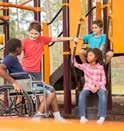
“Play is one of the main ways that children really consolidate their learning,” says Doris Bergen, a professor at Miami University’s Department of Educational Psychology. “The way we really make our skills permanent, enriched, and highly developed is often through our play experiences.”
TOUCHING BASE WITH…
CHARLOTTE HAYER

RICHMOND EDUCATION ASSOCIATION BUSINESS AND INFORMATION TECHNOLOGY TEACHER, DEPARTMENT CHAIR, COMMUNITY SERVICE COORDINATOR
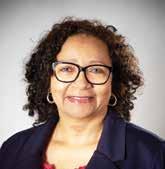
What do you like about your job?
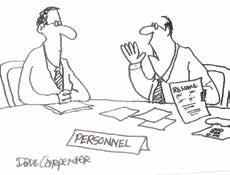
The thing that I like the most is getting to facilitate learning with students every day. I get to guide young people on this journey of lifelong learning with joy, peace, hope, challenges, wins, lessons, dreams, and aspirations, and I strive to do it with honesty and integrity.
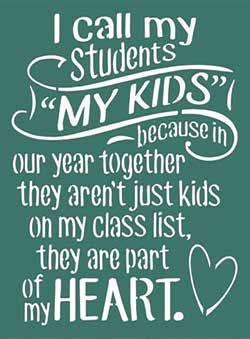
How has being in the Union helped you?
“I said, ‘How long were you a band director?’”
• Teacher: “Do you like to do your homework in the morning, after school, or at night?” Student: “Well…my mom does my homework, so I don’t even know how to answer this question!”l
Kathy Hirsh-Pasek, a psychology professor at Temple University, agrees. “Where do you find these features: something being active, engaging, meaningful, iterative and joyful?” she asks. “They coalesce under this behavior we call play.”l
Being a member has helped me improve and increase my advocacy voice for public education through the many professional development opportunities and leadership opportunities VEA offers. Being a union member has helped me by preparing and training me to help students, educators and education support professionals navigate public education and its systems. Being in REA/VEA allows me the opportunity to be a “light” for others. l
4 VIRGINIA JOURNAL OF EDUCATION | FEBRUARY 2023 VIRGINIA JOURNAL OF EDUCATION FEBRUARY 2023 5 UP FRONT
Photo and illustrations
iStock
by
1,486
Words in the longest run-on sentence in the history of an Idaho middle school, where an English teacher enlivened a grammar and punctuation lesson by challenging seventh-graders to write it. It takes more than seven minutes to read out loud and goes on for four pages in a Word document. Next for the students? Making the sentence grammatically correct.l
Not So Fast, School Closing Critics…

Some were quick to criticize states and districts for their school closing policies during the pandemic, blaming those closures for learning loss. New research by the Education Recovery Scorecard is showing, however, that such criticism may have been premature.
Co-led by a Harvard professor of education and economics, the research examined math and reading achievement in 29 states and found that while districts where extended remote learning went on during the 2020-21 school year did have larger declines in some areas than other districts in the state, the pattern was not consistent enough to identify school closures as the main reason.
“Achievement losses varied widely among districts that spent the same share of 2020-21 in remote learning,” researchers wrote, adding that future studies will look at other factors, including COVID death rates, broadband availability, and the leading sources of parental employment in the school district.

“A full recovery from the pandemic will require not just welltargeted, evidence-based efforts by schools and educators,” the report notes, “but coordinated efforts by healthcare systems, and mental health systems, social service agencies, community organizations, and other state and local agencies.”l
Learning =Taking Risks

I think the number one thing that I learned is that good teaching and learning is built on a foundation of risk-taking—learners’ willingness to take a risk, and teachers’ willingness to take a risk. Risk-taking means everything from a willingness to try out an answer and be wrong to a willingness to take leadership, cognitive leadership or project leadership. There are a lot of ways that it looks. But my mantra is: we can’t teach or learn anything unless we are willing to take a risk.l

Let’s Delete This!
Almost 15 percent of kids ages 9–12 experience cyberbullying, while about 16 percent of high school students are affected. High school and middle school teachers also report that cyberbullying happens frequently in 1 in 5 classrooms.l

Dr. King: True Then, True Now

“True education helps us on one hand to know the truth, but more than that, it helps us to love truth and sacrifice for it. I am convinced that if we are to move forward, that if we are to face the many problems of our world, education must take on that two-fold role it has traditionally done and give the individual a sense of moral and ethical values.”l
— Dr. Martin Luther King, Jr.
“It was a make-up test, so I just made up a bunch of answers.”
Social Media Oversight?

In Chicago, education officials have hired an outside firm to monitor the social media activity of the city’s public school students in an attempt to spot signs that students may be considering acts of school violence or self-harm. If such signs are picked up, school staff or law enforcement can plan potentially life-saving interventions. While more school districts are looking at such programs, there is little to no research out yet on their effectiveness, and some civil rights activists are concerned about privacy issues and potential misuse of monitoring strategies.
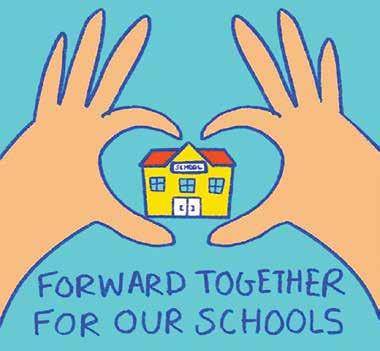
At press time, a Virginia Department of Education spokesman says he knows of no school divisions in the state that have instituted a social media monitoring program.l
“A vow of silence sounds great. I used to work in an elementary school.”

6 VIRGINIA JOURNAL OF EDUCATION | FEBRUARY 2023 VIRGINIA JOURNAL OF EDUCATION | FEBRUARY 2023 7 UP FRONT Photo illustrations by iStock
— Erica Rosenfeld Halverson, Professor and Chair of the Department of Curriculum & Instruction at the University of Wisconsin-Madison
SPEAKING TRUTH TO
When educators gather in Richmond to get the attention of legislators and policymakers, class is very much in session, and VEA members who came to the State Capitol for “Strong Schools, Strong Communities” Lobby Day had some very specific lesson plans in mind. Their objectives included making it very clear that our public schools can no longer withstand the consistent underfunding of Virginia’s Standards of Quality, which are really just minimal standards set by the Virginia Board of Education. The “classroom for a day” in Richmond also featured a review of the facts that Virginia, a wealthy state, has no excuse for ranking so low in per student state aid for schools or for paying teachers so far below the average salary of their peers across the nation.
feel guilty or accused of not caring for our students while also advocating for a fair and meaningful living wage. We are educated, experienced, and dedicated professionals and we deserve to be paid like it.”
Education Association of Norfolk member Patrick Barry had some very personal lessons to impart to his representatives. “I’m here for both myself and for my six-year-old daughter,” he said. “If we can fund schools better, she can have the life she deserves and I can be a better provider for her.”
as a profession, and our students will never get what they need from us.”
Face-to-Face in the Hallways of Power
Taking Dr. Fedderman’s words to heart, members left the rally to make the rounds in the General Assembly offices, putting faces on public schools and letting elected officials know what our students, educators, schools, and communities need most.
By Tom Allen
Here’s how Katie Seidemann, a Montgomery County Education Association member, laid out the salary situation for the crowd—and members of the General Assembly—at the rally that kicked off the day: “Call me crazy, but I believe that doing this meaningful work as a certified, educated, and experienced professional should also come with the dignity and respect of a living wage. The fact that, along with my fellow educators, we do what we do because we love our students, does not mean that I don’t also deserve a salary that reflects my education and experience as an educated professional. The fact that I love my students does not mean that my master’s degree is worth any less than anyone else’s master’s degree. The fact that I love my students does not pay the bills. And as educators, we should not be made to
Educators must be heard by policymakers, said Reagan Davis of the Chesapeake Education Association: “I want to make sure that students and employees of public schools have a voice in the things that affect their lives every single day.”



At the rally, VEA President James J. Fedderman told the educators, “We are here today for truth, to speak truth to power, so lawmakers in Virginia can hear us and know our position. What happens in the next year or two can set up down two very different paths: On one side is darkness and cowardice; on the other is bravery and enlightenment. If we don’t come together and raise our voices, speak that truth to power, we will never get what we need

Husband and wife Loudoun Education Association members Hugo and Cory Brunet visited Delegates David Reid and Suhas Subramanyam, sharing with them the importance of fully funding the Standards of Quality, supporting teachers who make the exceptional effort of pursuing National Board Certification, and the need to significantly boost salaries for education support professionals.
“I’m a school bus driver,” said Hugo. “We do very important work, and we must earn a living wage.”
Fairfax Education Association member Kimberly Adams
Photo by Lisa Sale and Olivia Geho
VEA members gather at the Capitol to school legislators about public education’s needs.
VIRGINIA JOURNAL OF EDUCATION | FEBRUARY 2023 9 8 VIRGINIA JOURNAL OF EDUCATION | FEBRUARY 2023
COVER STORY
POWER
led a group of FEA members into the office of Delegate Ken Plum, where she told him that the billion-dollar tax cut proposed by Governor Youngkin “is not helpful when we are in a position to do so much for public education.”

Plum, a VEA-Retired member and former public school teacher and administrator, agreed. “We need funding so we can add counselors and other mental health staff,” he told the FEA delegation. “There is so much trauma in our student population, and we have to take the burden off our teachers.”
Stephanie Lovelace of the Franklin County Education Association was among FCEA representatives who spoke with Senator William Stanley, pointing out how low
teacher salaries are contributing to a critical staff shortage in K-12 schools.

“We’re very understaffed locally,” she said. “In fact, we don’t currently have a chemistry teacher, which is forcing students who need that class for college to take it online, where they can’t do labs.” She points out that a higher percentage of those online students are failing the class than when there was a classroom chemistry teacher.
FCEA members Shannon Brooks, Heather Quinn, and Ashley McKelvey also had a chance to meet with Senator David Sutterlein and convey similar messages.
A group of Richmond Education Association members, led by REA President Katina Harris and Vice President Darrell Turner, urged Delegate Lamont Bagby to support lifting the
support cap, a funding mechanism put in place a decade ago that limits the number of education support professional positions in schools. They also talked about the ongoing process in our state of creating new history Standards of Learning and the controversy surrounding that effort.
Legislative Backing
Several legislators left their Capitol offices to step into the January cold and offer support for rally participants, adding to the Lobby Day optimism.


“Virginia is consistently ranked about number four among states in the nation for both achievement and safety,” Senator George Barker, who chairs the Senate Appropriations Committee, told the crowd. “We really do have

excellent schools, and you’ve done that in a state as diverse as any other state.”
Delegate Schuyler Van Valkenburg challenged his legislative colleagues to do better. “We all know that public education is a pillar of democracy,” he said. “But for years now, the General Assembly has neglected it. And now, when we have an opportunity to put our foot on the gas, we have a program that takes money out of public schools,” referring to Governor Glenn Youngkin’s proposal to shift budget funds into “laboratory schools.”
Other speakers included Senator Mamie Locke, Delegate Michelle Maldonado, Newport News Education Association President Dr. James Graves, and Virginia NAACP President Robert N. Barnette, Jr.l Allen is the editor of the Virginia Journal of Education.


Making their presence known: VEA members stirred up the Capitol, both inside and out, on Lobby Day. Legislators who spoke at the rally included (clockwise from upper left, this page) Sen. Mamie Locke, Del. Michelle Maldonado, and Del. Schuyler Van Valkenburg. Members also made office visits (from bottom row near left) to Sen. Locke and Del. Cliff Hayes, among many others.
NNEA President Speaks at Rally after School Shooting


Dr. James Graves, president of the Newport News Education Association and a technology teacher at Denbigh High School, spoke to the rally crowd in the aftermath of a teacher being shot and seriously wounded by a student at Richneck Elementary School in his city in January. Some excerpts from his remarks:
It’s been a long week. I have to say it’s been very hard for us, and not only for me, but for our executive board and our entire community. Please continue to pray for us, that things will change in Newport News and across the state of Virginia.
Gun violence and school safety are complex and intertwined problems, and I won’t stand here and act like I have all the answers. I cannot do that. It’s going to take all of us—legislators, parents, students, teachers, bus drivers, cafeteria workers. All of us have to come together to get a solution to these issues. I want you all to continue to strive and continue to fight—and to continue to pray for Newport News Public Schools. Make sure that your voices are heard in your school board meetings.
involved], we love you.l
10 VIRGINIA JOURNAL OF EDUCATION | FEBRUARY 2023 VIRGINIA JOURNAL OF EDUCATION | FEBRUARY 2023 11 COVER STORY
Miss Abby [Abigail “Abby” Zwerner, the teacher
Photos by Lisa Sale and Olivia Geho
Why, How, and What Difference Does It Make?
Why did you choose to pursue National Board Certification, and what does it mean to you?
National Board Certification is widely seen as the most meaningful and respected form of certification a teacher can earn, a credential designed to not only cultivate and keep the best classroom professionals we can, but also to serve as a form of honor and recognition for those who have it.
The process, as you might imagine for such an achievement, is not a walk in the park. It’s supervised by the National Board for Professional Teaching Standards and involves four separate components (see box on page 14). Only about 130,000 teachers nationwide have earned the certification.
To better understand their motivations, experiences, and benefits, we asked several VEA members who are National Board Certified Teachers (NBCTs) to share some thoughts.
I was in a time when I was reflecting and seeking to improve aspects of both my personal and professional life, to maximize the gifts and talents I felt I’d been given. I was looking for positive results in my character, work ethic, relationships, faith, and fitness, and I’d say the National Board process hit all five areas. I realized that I wasn’t challenging myself enough, professionally, and that my students would lose out if I didn’t give what I deemed to be my personal best. They were learning a lot, and school was going very well, but I felt I wasn’t providing them with my full potential. So, I took on the NBCT process and, as many others have said, it really is the most influential, applicable, and long-term professional development I’ve encountered. My teaching became more analytical, reflective, and refined, and my classroom became more student-centered and differentiated. The NBCT process has afforded me a sense of accomplishment, a renewed focus, and a sense of duty in different aspects of the profession, both locally and nationally. My students have benefited with an improved classroom culture, increased engagement, a teacher who seeks out and provides professional development, and a more valuable academic experience, overall.
— Kristian Ellingsen, a high school health and physical education teacher in Loudoun County

A colleague who’s a NBCT talked to me about it, and I realized that it could take me on a road of reflection and discovery that would make me take a step back, analyze what I do and help me focus more on my students and their needs. I knew that such a process would make me a better teacher. It was absolutely a great journey! I discovered my strengths as a teacher, renewed my practices and lessons, and I also identified areas where I could do better for my students. Achieving National Board Certification also made me feel proud, like my efforts in the classroom were recognized. It is an achievement that I cherish because it made me push myself for the benefit of my students.
— Lilliana Maldonado-Mendez, an IB high school Spanish teacher in Arlington
Originally, I chose to pursue National Board certification because of the promised supplemental pay increase. However, I did not earn my certification the first year. I was extremely disappointed and had decided I would not pursue it any further. One of my students changed my mind. During my first certification pursuit, I had to videotape
my classes. I had explained to each class the purpose for the videos and informed them I wouldn’t know if I was certified until November of the next school year. The next year, one of my students remembered this and asked me if I had earned certification. I told them I had not. The student then asked if I had another chance, so briefly explained how scores were banked and how I could resubmit work for some parts of the process. The next question changed my purpose and desire for obtaining National Board Certification: “So, what are you going to do now?” knew I could not say I had decided not to pursue certification anymore—I always tell my students to take advantage of opportunities to improve themselves. I had to live up to my own words. I had to follow through, and I’m so glad I did.
— Stephanie Harry, a high school science teacher in York County
What was the hardest part of the journey?
Time management: I didn’t heed the warnings of those that went before me or their valuable advice to plan out each component ahead of time to ensure a variety of evidence was included. Planning, adjusting my plans, and managing my time to complete requirements were challenges. Make sure you plan, plan, and plan again, while adjusting as you move forward.
When doing maintenance of my certificate (renewal), my challenge was to find a quiet place to reflect, plan, and write. I now have a family with young children involved in many extracurricular activities, so I had to purposefully set aside time


to accomplish this work.
— Dr. Sherry
Beach
J. Harrell,
a middle school social studies teacher in Virginia
The hardest part was finding time to write. I’d stay after school at least one day a week to write and revise for three or four hours. I’d get home at 7 or 8 at night, tired but happy that at least I wrote something (it also made my son an expert at ordering takeout). Gathering and selecting all the materials was also a challenge. When the deadline approached to mail my entries in “the box” I was very nervous. It took me about five hours to put my box together with the help of two colleagues. It was worth it!
— Lilliana Maldonado-Mendez
One of the challenges I faced was understanding the certification process. I did not have the advantage of working with a cohort and did not know about VEA’s Jump Start program, so understanding each of the components was extremely challenging. I currently serve as a VEA Jump Start facilitator. I wish I would have had access to this training when I was a candidate. The tools taught in this workshop would have made the certification process less challenging.
Stephanie Harry
What difference has being a NBCT made in your approach to what you do?
First, I have felt empowered, knowing I’m capable of contributing valuable insight and work to difficult classes, schools, groups, and problems. Certification has also helped to give me credibility in these different
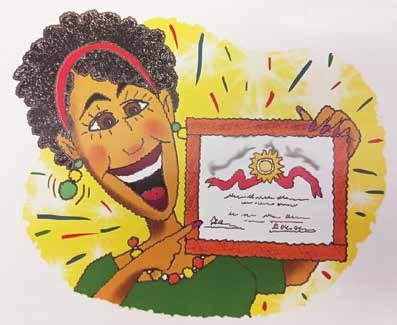
12 VIRGINIA JOURNAL OF EDUCATION | FEBRUARY 2023 VIRGINIA JOURNAL OF EDUCATION | FEBRUARY 2023 13 FEATURE STORY Illustration by Judge Cohen
VEA members/NBCTs talk about why they pursued National Board Certification.
environments. I’ve found myself seeking opportunities to contribute and affect positive change.
I believe the single factor most affected by achieving certification has been my desire to contribute to the profession of education as a whole, rather than only within the confines of my room. I’ve felt a call to contribute to and elevate, if at all possible, efforts to increase teacher retention and to provide professional development, and also to take on additional leadership roles.
— Kristian Ellingsen
and can do. The way I plan, facilitate instruction, and assess students is now based upon student interests, knowledge, and skills.
— Dr. Sherry J. Harrell
greatly affected by joining a cohort of support organized by the VEA!
 — Kristian Ellingsen
— Kristian Ellingsen
I now approach teaching and learning through a completely different
lens. Prior to my National Board journey, I approached instruction as a process in which provided learning experiences—not really focusing on whether students participated or not. After delving into my practices and looking at the impact my planning and instruction had on student learning, I was faced with the hard reality that my actions were not maximizing their learning potential. About this time, was introduced to the Architecture of Accomplished Teaching and the reflective thinking processes necessary to meet the needs of students at this “hour” in education. This shift in thinking about my practices has changed the way approach teaching and learning forever: Instead of creating lessons and presenting them, I now begin with who are the children and what they know
I became a more inspired and better teacher. It gave me more “ganas,” more desire to do well for my students, to improve and try new things, and to challenge myself. One big change has been that I take time to reflect: How am I doing? Are my students learning? How can I help them do better? It also developed in me the habit of stopping and thinking more often about how and why I teach.
— Lilliana Maldonado-Mendez
What would you say to a colleague considering pursuing National Board Certification?
I encourage them to pursue the process, enroll in a Jump Start program, and take advantage of the resources and candidate support available. The process is not easy, but the certification is most definitely worth it.
— Stephanie Harry
I’d tell them to focus on backwards planning. You have to research the components for your specific content area to get a basic understanding of what’s required. Next, figure out the submission and payment deadlines to see if it’s feasible for you. Third, carefully choose your components and the order in which you’ll complete them. Take into account your busy times of the year and your family and professional obligations. Once you’ve done this, I’d say dive in and pursue National Board Certification with positivity, patience, and perseverance. Of course, the whole experience will be
Do it! This has been the most beneficial professional development of my career. This journey is individualized and allows one to analyze the impact your practices have on students’ learning. National Board Certification provides the opportunity to reflect on what you’re doing in the profession while learning to effectively serve your current students. Finally, obtaining National Board Certification teaches you the thinking process of knowing one’s students, making instructional decisions based on this knowledge, measuring student learning, and using that data to make next-step decisions. This process is timely, applicable, and will change the way you view teaching and learning.
— Dr. Sherry J. Harrelll
What is National Board Certification?
The National Board for Professional Teaching Standards (NBPTS) is a national standards board that defines and recognizes accomplished teaching across different subject areas. Educators seeking National Board Certification undertake a process in which they demonstrate accomplished teaching by completing four components:
1. Content Knowledge
2. Differentiation in Instruction
3. Teaching Practice and Learning Environment
4. Effective and Reflective Practitioner National Board Certification provides meaningful, self-directed professional growth along with national recognition and opportunities for career advancement. For more information, visit nbpts.org
ON THE LIST!
The many benefits, for students and educators, of list-making.
By Mary Anne Em Radmacher
Making lists is one of the most effective ways to distill thoughts into brief, clear statements while establishing problem-solving skills, developing prioritized tasks and introducing the value of a personal writing practice. List-writing contributes to both shortterm results and long-term objectives

Everyone learns more quickly through familiar examples. So, when I talk about lists to kids, I start with shopping lists and George Washington. Kids know what shopping lists are. And nearly every student has heard of George Washington.
As a teenager, Washington relied on a list to guide him into adulthood. At some point, he acquired a French book written in the late 1500s about good citizenship and manners.
He first extracted from the book a list of 110 rules of civility, writing them out nearly verbatim, then made a
second list based on language that made sense to him.
Students have long followed Washington’s practice. It improves retention to read or hear something, want to remember it and follow this system:
1. Write out the main points as they are originally expressed.
2. Write the main points in personal language.
3. Write the list again, this time using personally relevant examples and situations.
Washington used list-making to help remember and internalize civility rules, principles which supported him through many of the occasions and decisions of his life, and he wasn’t the only historic figure to rely on lists. Roman Emperor Marcus Aurelius kept a list of ideas, principles, poems and
teachings that were influential. It has endured for more than 2,000 years and is available today in book form: The Meditations of Marcus Aurelius Thomas Jefferson maintained lists of many of his interests and Ralph Waldo Emerson lists to document his voracious reading habit.
The Value of List-Making
Over the years I’ve asked hundreds of people aged 6 to 96 questions about list-making. We begin by asking, “What benefit is there to going to the store with a shopping list?”
Some common responses:
• You remember what you came to get.
• You wrote stuff down as you noticed that you needed it.
• It keeps you from getting frustrated while shopping.
• You get what you actually need.
Photo by iStock VIRGINIA JOURNAL OF EDUCATION | FEBRUARY 2023 15
FEATURE STORY
14 VIRGINIA JOURNAL OF EDUCATION | FEBRUARY 2023
• It keeps you within a budget –you don’t spend money on stuff you don’t need.
• You save time—you don’t have to go to every aisle of the store. Then I ask, “Is there a benefit to going to the store without a list?”
• You can save money by looking for all the things on sale.
• It’s more fun.
• If you’re hungry, you can get something and eat it right away.
• You might get something you’ve never noticed before.
These are surprisingly fun and creative answers. The third question is the pivot point: “Can you think of any other parts of your life that would benefit from making a list?”
Participants surprise themselves with the number of ideas they generate. The benefits of keeping (or not keeping) a list are applicable across an array of ages and life experiences.
• A teenager reported that keeping a list helped her find the ideal prom dress.
• Incarcerated individuals in the weeks before their release said lists helped them identify the kinds of jobs and housing they wanted and ways to keep track of the requirements of release.
• Executives have used lists to track employee potential, stay aligned with objectives, identify bottlenecks, and improve under-performing systems.
List-Making and the Brain
Thinkers have understood the value of keeping lists since the time of Marcus Aurelius, at least – but proof is still coming in. The National Library of Medicine reports that as early as 1949, studies were being done
on the value of collecting information and putting it on a list. Recent neurological research underscores even more benefits to keeping a list: It frees up the brain’s short-term holding capacity. Once something is written down, the brain is satisfied that an action has been taken. That can reduce anxiety, making a host of benefits accessible.
My Life of Lists
My first attempts at poetry were more like lists than poems, usually three or four words per line. List-making turned out to be early training for the clarity and brevity required for writing poetry and aphorisms.
Making lists helped me develop my capacity for breaking down complex subjects into manageable elements. In fourth grade, I wrote a play based on all we had been taught about the judicial system. I wrote character development guides and an overarching review of the case we would be considering. Students were assigned roles with specific backstories: judge, bailiff, sergeant-at-arms, lawyers, jury members, and so on. I organized this material by creating lists of job requirements and character traits. When the teacher retired, she told me she’d used my courtroom exercise every year!
List-Making and Journaling
Convincing people of any age of the value of maintaining a personal journal practice can be daunting. Many people don’t like writing in longhand; others find composing sentences that flow and make sense a challenge. Some are so concerned with getting things “right” that they miss the value of personal journaling altogether. This is where list-making takes the writing
and thinking spotlight.
People born in the past 20 years have increasingly abandoned handwriting in favor of keyboarding. They’re distinct processes and each has particular advantages and specific brain pathways, but the value of keeping lists is sustained either way.
The brain processes both methods differently but the benefits are much the same. List makers learn to clarify and articulate their thoughts, and are liberated from the labor of holding information in short-term memory and transferring it into longterm mental storage.
Handwriting connects to the sensory processing parts of the brain, giving the learner more memory hooks upon which to hang information, according to Professor Audrey van Der Meer, a Dutch neuroscientist. Handwriting also provides richer engagement with information as it’s done by holding and moving a physical writing implement. Professor van Der Meer advocates writing and drawing from an early age as essential for comprehensive brain development, a view shared by neurologists around the world.
Keyboarding provides speed but creates distance from the information, but because our current students have grown up doing it, they find it more comfortable and familiar. Keyboarding can be the ideal tool for the type of list that is often called a “brain dump.” Speed is an asset in that kind of list, as the goal is to identify as many problems, solutions, or ideas as possible.
An excellent way to handle lists is also to verbalize their items. The advantages of this are manifested over a longer period than handwriting or keyboarding. It allows us to answer the question “What are you thinking?”
Current technology has made it easier to access, preserve, and express lists by
speaking them aloud. This may help explain the intimacy and personal details that people record and share on social-media platforms.
Like keyboarding, verbalization can remove the tactile experience of interacting with information in the kinesthetic and brain-enhancing way that handwriting uniquely provides.
I advocate handwriting lists, as my personal and professional experiences support this preference.
List-Making in the Classroom
With students of any age, a good way to start is with the three questions near the beginning of this article. First, develop a common understanding by asking, “What is a shopping list?” Then proceed to the three questions:
1. What are the benefits of going to the store with a list?
2. What are the benefits of going to the store without a list?
3. What other parts of your life –things, experiences, challenges, opportunities – would benefit from creating a list?
Divide students into groups of three to five and give them time to generate complete answers, then have one person report the results to the whole class. Collect the answers and you’ll have a generative document that can be amended as students add discoveries.
You can build list-making into many parts of learning. For example, students can list actions needed for the next school day. They don’t have to know they’re identifying and prioritizing tasks, as they will later need to when adulting.
Various assignments can end with list making. Some examples:
• Five key points in this process.
• Three ways you can imagine this
being important in your life.
• One thing that seems important that was not included.
• Three things that the character in this story found delightful (helpful, challenging).
Students create these lists with key words, without constructing whole sentences and transitions.
From their lists, ask them to write a paragraph that expands their thinking. This also develops the skill of creating an outline (which is simply a list of consecutive elements) for writing, projects, and other uses.
Making Lists Personal
After students have been safely introduced to the process of list-making, you can ask them to move to more challenging applications, such as using lists in their own lives. Each teacher must determine how a more personal list-making system can be honored with privacy while still being part of the classroom experience. Some have successfully operated with the “show me that you created five different lists this month” method – without reading the contents of the lists. The honor system is also an option.
This transition from educational lists to personal applications is a delicate pivot point to inspiring students to use lists for personal inquiry and problem-solving. Students may gain insights from the lists they create:
• Why am I so tired?
• Reasons why my family argues.
• Things I want to do when I grow up.
• Books I want to read.
• Places I want to go.
Over the past three decades, I’ve provided thousands of blank
notebooks and composition books to students, inviting them to explore the personal benefits of making lists and exploring them in deeper ways. This practice accesses what neurologists call inner speech. Students begin to come to a greater understanding of their own experiences by putting their thoughts and feelings on the list.
Making Experience Tangible love to show students the battered leather daily ledger my father kept when he was in the military. He listed key events daily. Decades later, it gave me insight into a part of his life that he never spoke of and helped me understand him in a new light.
Keeping lists can do the same thing for students. Doing so helps clarify next steps and can reduce anxiety, while teaching personal agency and accountability. List-making is a way for students of different capacities to connect to their life experiences.
Not everyone who keeps lists in the classroom will develop a lifelong habit. But some will develop the skill into an important personal practice. A young woman who learned list-making from me as a sixth-grader wrote to me after her third book was published, saying that the skills she learned that day put her on the path to clarity of expression and a deep love of writing by hand.
The methodology I call “on the list” will help your students to be better thinkers and healthier humans.l
Mary Anne Em Radmacher is an artist, poet, and consultant who has proven that art, creativity, and communication skills are crucial to the success of any organization. She is perhaps most well-known for these lines from her poem: Courage doesn’t always roar. Sometimes courage is the quiet voice at the end of the day saying, “I will try again tomorrow.”
VIRGINIA JOURNAL OF EDUCATION FEBRUARY 2023 17
FEATURE STORY 16 VIRGINIA JOURNAL OF EDUCATION | FEBRUARY 2023
Good Trouble’’
VEA
By Taisha Steele
VEA members hold racial and social justice as core values for at least four reasons: One, we promised members of the Virginia Teachers Association we’d always support their mission of educational equity when VTA and VEA merged in 1967. Two, we’re committed to improving life for our students, members, and communities. Three, we’re determined to raise awareness about and advocate to destroy institutional racism in our schools. Four, we understand the need for policy changes to promote a just public education in our schools and for holding our politicians accountable on this issue.
VEA’s Department of Human and Civil Rights (HCR) was established in 2018 to champion this work. Here are some of the highlights of our efforts to date:
This month, HCR will host our fourth Summit on Teachers of Color, featuring a presentation from Dr. Bettina L. Love, the renowned author of We Want to Do More Than Survive: Abolitionist Teaching and the Pursuit of Educational Freedom. That volume was the focus of a VEA Leaders for Equity and Justice book study last summer. There will also be a panel of National Board Certified Teachers of Color to bring awareness to this credential, including potential barriers and benefits for teachers of color. The summit aims to inform policy and promote best practices and greater diversity in hiring methods in K-12 education in Virginia, because VEA members are working to promote progress in these significant areas affecting minorities in education: climate and working conditions, retaining teachers of color, diversifying the pipeline through educator preparatory programs, social justice, culturally relevant practices, cultivation of community, and compensation.
As HCR’s director, I support local education associations, members, and VEA committees in multiple ways. I
serve as staff liaison to the Fitz Turner Commission for Human Relations and Civil Rights (FTC), the Minority and Women’s Concerns Committee (MWCC), the LGBTQ+ Ad Hoc Committee, and the HCR Training Cadre. Recently, FTC and HCR revised the Black Lives Matter at School Toolkit and hosted Black Lives Matter at School Week of Action activities in early February. VEA and HCR encourage educators, students, parents, unions, and community organizations to join this annual week of action, use the BLM at School Toolkit, adopt the Resolution for BLM at School, and hold events to promote racial justice. FTC also presents three annual awards, whose winners will be honored at the Delegate Assembly in Roanoke in March.
MWCC and HCR began hosting VEA Vibe Checks two years ago. These are virtual gatherings offering a safe space for VEA members to have honest conversations about equity and justice issues. Vibe Checks allow members to connect and support and care to one another. Among other projects HCR has created:
• The LGBTQ+ Ad Hoc Committee produced a new logo and revised Toolkit for Promoting Inclusion for LGBTQ+ Students and School Employees last fall. This very timely resource provides materials to support the safety of the LGBTQ+ community in our schools.
• HCR partnered with NEA to do implicit bias training for the HCR Cadre, with the objectives of learning to define implicit bias, identify key characteristics, and identify steps and strategies to challenge it.
• The HCR Cadre supports locals by providing trainings on a range of justice issues, raising awareness, preparing for local actions, and promoting equity.
• HCR annually coordinates Read Across America events, partnering with Richmond Public Schools, community organizations, and public officials to demonstrate excitement and the joy of reading, with a focus on culturally diverse books and authors.
• HCR is leading an internal cadre to develop justice priorities for VEA staff, such as professional learning, document language revision, and communicating the diversity, equity, and inclusion work and justice projects happening in our union. The goal is to use a racial and social justice lens in all departments. As we continue to fight for racial and social justice in Virginia’s schools, VEA is proud of the work being done by our members through the Department of Human and Civil Rights and is eager to continue building on that foundation.l
Taisha Steele is the director of the VEA’s Department of Human and Civil Rights.
Loneliness Gets ‘Benched’
A Culpeper school joins the Buddy Bench movement.
 By Simone Kiere and Colleen Brady
By Simone Kiere and Colleen Brady
principal, Dan Birch, with the concept and request for a buddy bench earlier this year, he thought it was a great idea. Through the generous support of our Parent-Teacher Organization, we were able to acquire the materials to build not one but three buddy benches—one for each of our grade level playgrounds.
The magic of buddy benches, and what distinguishes them from regular benches, is that students use them to reach out to classmates. So, to ensure the success of the new buddy benches at Pearl Sample, we have taken steps to make sure that our students know about and understand how to use them. First, we guided students to rehearse and perform a demonstration to model both how a student might use the bench and how to approach someone on the bench. Then, for the next several weeks, we had each class take turns serving as “Buddy Bench Ambassadors” for a week during recess, meaning that one or a few students from that class spent a few minutes at the beginning of each recess sitting on the bench to model appropriate use and encourage others who might be hesitant to use it.
The goal of buddy benches is for everyone to have someone to talk to or play with, and that we all, in the words of Judith Ashton, co-founder of Buddy Bench Ireland, “look up, look around and look out for each other.”
Buddy benches are said to have arrived in the U.S. in 2013, thanks to a first-grader named Christian in York, Pennsylvania. When he learned that he would be moving to Germany—to a new school in a completely new country—he was worried about making friends. But then he learned that one of the schools he might attend had a special bench where students could sit to indicate that they wanted someone to play with. Christian was so excited about this idea that he immediately asked his principal to install one at his current school. The principal loved this idea as well, and so began the nationwide phenomenon of “buddy benches,” which are now a fixture in thousands of schools across the U.S., as well as several other countries, effectively counteracting loneliness.
Buddy benches are used by young students every day to help reinforce communication, empathy and support for one another, which are all qualities we value and encourage at Pearl Sample Elementary School in Culpeper. So when we, the school counseling team, approached Pearl Sample’s
The buddy benches are a reminder to be kind to each other and include everyone. True to the spirit of the buddy bench itself, this was a school-wide team effort. In the first few weeks after the buddy benches were installed, the students have loved using them and have already begun sharing stories of how well they are working.l
Simone Kiere, a Culpeper County Education Association member, and Colleen Brady are the school counselors at Pearl Sample Elementary School.
Four Reasons to Sit on the Buddy Bench
1. When you are new to the school.
2. When you want to make new friends.
3. When your friends aren’t at school that day.
4. When you want to play something different than what your friend is playing.
Source: The Bench Factory
18 VIRGINIA JOURNAL OF EDUCATION | FEBRUARY 2023 VIRGINIA JOURNAL OF EDUCATION FEBRUARY 2023 19 FEATURE STORY
FEATURE STORY
Pearl Sample students checking out the school’s new Buddy Bench on its first day of use.
“
members fight for justice through our Union’s Human and Civil Rights Department.
Williamsburg/James City Members Go On the Offensive
Williamsburg James City Education Association members got what seemed a respectable salary boost going into this school year—until they stacked it up next to the increase they faced in health insurance costs.
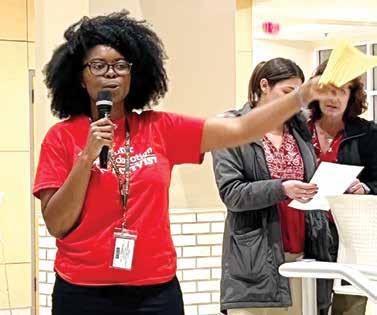
“The raise was almost swallowed up by the health care increase,” says Alynn Parham, WJCEA’s president, who also notes that Williamsburg/ James City has lost teachers to better-paying localities nearby.
So WJCEA made a plan and has stepped up its advocacy this year, beginning with an impressively-attended rally at the local school board. “We were well received,” Parham says, “and they applauded our professionalism. But they also pointed out that the final funding decisions are made by the Board of Supervisors.”
So, WJCEA made the Board of Supervisors the next stop, filling the meeting room with
History! Richmond Union Bargains, Ratifies Contracts
members wearing red at its next monthly meeting. Among the speakers was WJCEA treasurer Andy Cason, who told supervisors, “The situation is dire. Educators will leave for other divisions, retire early, or leave the profession altogether.”

WJCEA members won’t give up as the budget process continues through the winter and spring. “We will continue to advocate by communicating with our division leaders and funding partners,” says Parham, “and we’ll continue to build relationships with parents and community supporters to ensure the progress of public education in Williamsburg-James City County.”l
VEA to Convene Annual Delegate Assembly
VEA’s annual convention will be an all in-person event this spring, slated for March 16-18 in Roanoke. Hundreds of members from across the Commonwealth will gather at the Hotel Roanoke to chart VEA’s course for 2023-24, debate items of new business, and approve a budget and policy resolutions.l


In a huge, historic step forward, members of the Richmond Education Association have negotiated and ratified their first collective bargaining agreements with Richmond Public Schools. Four separate bargaining units have now completed the process: Instructional Assistants, Licensed Personnel, Care and Safety Associates, and Food Service Workers, and the contracts will go into effect for the 2023-24 school year. These agreements, now also ratified by the city’s school board, include significant salary increases, improved planning time protection and/or meaningful compensation when asked to work during planning time, and many other excellent provisions.
UPDATE
At press time, 28 VEA locals have active collective bargaining strategies underway, some in the planning stage, some in the midst of gathering signatures in card campaigns, some negotiating with local governing bodies to have the necessary resolutions passed, and some holding certification elections. Just a few examples:
• Card campaigns are underway and gaining momentum in the Arlington Education Association, the Education Association of Alexandria, and the Falls Church City Education Association.
• In Petersburg, the city’s school board will be voting on the Petersburg Education Association’s bargaining resolution shortly.
• At press time, the Prince William Education Association is conducting a certification election for both certified and classified staff after meeting the requirement for percentage of signed authorization cards.l

Reading is the Key to Success
When we make time to read with kids, children get the message that reading is important and fun. When we read books that have characters of all races, genders, and backgrounds, students discover their own voices and learn from the voices of others. That’s the goal of NEA Today’s Read Across America Day. Learn more about this annual nationwide celebration of reading and literacy at www.nea.org/readacross l

VIRGINIA JOURNAL OF EDUCATION | FEBRUARY 2023 21 MEMBERSHIP MATTERS 20 VIRGINIA JOURNAL OF EDUCATION | FEBRUARY 2023
of
Roanoke by iStock
Photo
Hotel
WJCEA President Allyn Parham (top) speaks before members attend School Board meeting. Members gather (below) before taking their case to the Board of Supervisors.
Dombretta Joins VEA Staff
Lawrence Drombetta, has joined VEA’s Legal Advocacy department as a new staff attorney. He’s assisted our legal department in the past and has over 12 years of litigation experience.l
NEA Fights for Debt Relief
Fifty-nine percent of educators dealing with student loan debt say it hampers ability to create emergency savings and 40 percent say paying off such debt negatively affects their mental, emotional, and/or physical well-being.
Statistics like that—and, more important, educators like that—are why the National Education Association has filed an amicus brief in Biden v. Nebraska and Department of Education v. Brown, arguing that the Biden administration’s student debt relief plan, which can cancel up to $20,000 of federal student loan debt, is a valid exercise of authority granted to Education Secretary Miguel Cardona by Congress.
“Nearly half of educators have outstanding student loan debt, owing, on average, $58,700…This relief, though individual, will have implications across the profession as financially secure educators are less likely to leave the profession,” the brief argues.
The Supreme Court is scheduled to hear oral arguments in the student debt relief case on February 28.l
VEA Loses Stalwart with Passing of Walt Mika VEA Members, Teaching and Learning Department Honored
VEA’s Teaching and Learning Department, headed by Director Melinda Bright, and a team of VEA members have been honored for their outstanding work by the National Staff Association for the Improvement of Instruction (NSAII). At the NSAII conference last fall, VEA’s team took home the Professional Learning Workshops & Conferences Award for developing and presenting VEA’s Trauma Workshop, which toured the state last summer, offering sessions from Tidewater to Southwest Virginia. Dr. Amber Brown, Teaching & Learning Specialist, facilitated members in the development of content and a training team to deliver the workshops.
The topic was extremely timely, the workshops were popular, and the evaluations were overwhelmingly positive. Eighty-three percent of participants who responded on the evaluations said the information they learned would be “very helpful” in affecting student success; a full 100 percent said the workshop added value to their VEA membership.
The Trauma Workshop is now available to locals and school divisions, either in its original 5-hour format or in a modified 3-hour version.l

Walter J. Mika, Jr., who served the Virginia Education Association in numerous capacities, including as president from 1980 until 1982, died in December at the age of 83 after a battle with Alzheimer’s Disease.

Mr. Mika, an Ohio native who became a 30-year veteran high school
KUD S
history teacher in Fairfax County, was also VEA’s vice president, a member of the VEA Board of Directors and numerous other VEA statewide committees, including the executive committee, and president of the Fairfax Education Association.

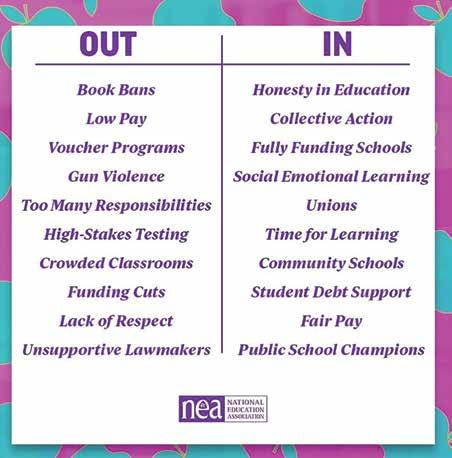
In addition to his many roles at VEA, Mr. Mika was also appointed to the Virginia Retirement System’s Board of Trustees in 1982, where he spent 10 years fighting for educator retirement rights. He was widely respected for his knowledge of retirement issues and his advice was sought by legislators and other state officials.
Mr. Mika was also a longtime political activist, serving as a member of the Fairfax County Democratic Committee and Braddock District Committee chair.l
Bauer Among Educators Elected to NBPTS Board
VEA Vice President Carol Bauer an elementary school teacher in York County, is one of four educators nationally to be elected to join the Board of Directors of the National Board for Professional Teaching Standards. Bauer, NBCT and the 2016 winner of VEA’s Award for Teaching Excellence, was also chosen to serve as vice chair of the NBPTS Board.
Winchester Education Association member Jill McDaniel is one of Virginia’s two nominees for the U.S. Department of Education’s RISE (Recognizing Inspirational School Employees) Award, which honors exceptional education support professionals. She’s driven school buses in Winchester for more than 40 years, logging over 300,000 miles.
Richmond Education Association member Christal Corey who teaches middle school science and civics at Franklin Military Academy, has been named 2023 Richmond Public Schools Teacher of the Year.
Jeff Keller a Winchester Education Association member and history teacher at Handley High School, has been named the city’s 2023 Teacher of the Year. He teaches AP U.S. History, World History, Honors World History, and African American History.
The NEA Foundation’s Global Learning Fellowship (GLF) Class for 2023 has been selected and includes Desyl Wood, a science teacher at Patrick Henry School of Science and Arts in Richmond. GLF is a year-long program that includes a two-day professional development conference and an international field study.l

VIRGINIA JOURNAL OF EDUCATION FEBRUARY 2023 23
MEMBERSHIP
22 VIRGINIA JOURNAL OF EDUCATION | FEBRUARY 2023
MATTERS
Are Cell Phones and Classrooms a Good Mix?
Cell phones are, of course, everywhere now—and, increasingly, in the hands of younger and younger children. What, if any, should be the role of such devices in our classrooms? The Metropolitan Educational Research Consortium (MERC), based at Virginia Commonwealth University, recently compiled a research brief which looked at some school division policies, legal issues, and arguments for both more and less restrictions in policies determining cell phone use in schools. Here are some of those arguments, which may help facilitate conversations in your school and division.
Arguments for more restrictive cell phone policies
• Cell phones are a digital distraction from teaching and learning. One of the primary arguments against cell phones in schools suggests that cell phones disrupt school operations, are a distraction from teaching and learning, and have negative impacts on student academic achievement.
• Cell phones have negative behavioral and social emotional impacts on students. Excessive screen time has raised concerns about negative effects for students, especially younger students, and encouragement of antisocial behavior. Research has shown the relationship between cell phone use and increased levels of anxiety. A key concern here is the use of the social networking functions of cell phones to bully other students.
• Cell phones may be used within schools in disruptive, dangerous or unlawful ways. In school assessment situations, cell phones may be used for cheating. There are also concerns about the use of cell phones to coordinate unlawful activities.
• Cell phones within schools may increase concerns about surveillance of students and invasions of privacy.
Arguments for less restrictive cell phone policies
• Cell phones are powerful tools that can be integrated into teaching and learning. The most prominent argument for less restrictive policies is that cell phones have the potential to support student learning. Modern phones have many technology tools that are useful in classroom contexts including cameras, microphones, stop watches, calculators, and rulers. Students may also use them to do research, access tests or quizzes, or engage with education applications. However, research has also explored the readiness of teachers to integrate cell phones into teaching practice and the need for professional development in this area.
• Cell phones provide access to digital technologies for students with economic disadvantage. While many students may have laptop or desktop computers available at home, in economically disadvantaged communities, cell phones may be the only access point to online education resources and applications. In this case, a ban on cell phones raises equity issues. At the same time, solely having access to a cell phone may not be sufficient for completing schoolwork.
• Cell phone use is part of 21st century life; students need opportunities to develop skills in responsible use of technology. Increasingly, cell phones are integrated into our social, economic and political life.

• Cell phone bans put teachers in unnecessarily adversarial roles with their students leading to increases in disciplinary actions.
• Cell phones enhance school safety. Some argue that cell phones are needed for communication with family and emergency services in the case of a school shooting or a dangerous weather event.
You can read the entire MERC brief at www.vea.link/ MERCphones.l
Talking with Students Who Have Hearing Loss
Some tips for having effective communication with a student (or anyone else) who has hearing loss:

Face them. Many with hearing loss rely on visual cues and lip reading to help them understand. Position yourself in front of your student so they can see your expressions, gestures, and body language. Don’t yell. Yelling will distort the way you sound and the way you look, making it more difficult to be understood. Instead, speak slightly louder than normal. Speak clearly and distinctly without exaggerating your words. There’s no need to shout.
Repeat and rephrase. If your student doesn’t understand something you’ve said, repeat it once. If understanding is still a problem, rephrase it using different words. Some words or phrases can be difficult to hear.

Don’t say “never mind.” If a student asks you to repeat yourself or asks for clarification, don’t respond with phrases such as “never mind,” “forget it,” or “don’t worry about it.” These are dismissive phrases and serve to make people with hearing loss feel excluded from conversation.l
StoryCorps is an award-winning online project that defines its mission as “to preserve and share humanity’s stories in order to build connections between people and create a more just and compassionate world.” For its efforts, StoryCorps has been honored with both a Peabody Award and a MacArthur Award.
The organization now offers a schoolbased program, too, offering students a chance to expand their learning and build new relationships. You’ll find lesson plans and other resources at storycorps.org/discover/education, where teachers can also sign up for a newsletter or join a StoryCorps in the Classroom Facebook group.l
Have We Got a Story for You An Uphill Battle

Every Day
Those are the schools I taught in at the beginning of my career, so I know it, saw it firsthand – the schools that have been underserved for decades. This is not new. This is chronic, it’s systemic. It absolutely is tied to the systemic racism and economic inequalities and injustices that are in every social system. The educators in those places do the best they can, but they can’t keep standing in every gap where all the systems have failed those students and their families. They can’t do it.l
NEA President Becky Pringle, on underfunded and often-overlooked schools

VIRGINIA JOURNAL OF EDUCATION FEBRUARY 2023 25 Photos and grahic illustration by iStock 24 VIRGINIA JOURNAL OF EDUCATION | DECEMBER 2022 INSIGHT ON INSTRUCTION INSIGHT ON INSTRUCTION
The Artist at Work

Educators serving in the classroom demonstrate the creative, imaginative, and intellectual talents of artists. We design environments for and with young people where human learning occurs in complex ways across identity, sociopolitical realities and lived experiences.

Our work is more than just the hours spent with young people in the classroom. It’s the preparation that goes into teaching multiple lessons in a day, reflections on our teaching after a long day at work, the relationships we build with young people to support their humanity and learning, and the connection with other colleagues and families to support students.l
— Corey Winchester, an Illinois high school history and social studies teacher and an instructor in the teacher education program at Northwestern University

The Kids Can Handle It
From an editorial in the (Charlottesville) Daily Progress on the controversy surrounding the Youngkin Administration’s re-draft of the state’s Standards of Learning for History:
Americans are strong enough to withstand their history—good, bad or ugly. This country’s excellence springs not from guilt, but from a drive to do what is just. When we realize we made a mistake, we try to fix it. And we keep trying. It took far too long to address slavery, which is one reason the ugliness of racism bleeds from our body politic today. That by itself is a call to action for future generations to continue a job started by some of our greatest Americans but not yet completed.
We believe that America is the greatest country in the world because it strives to offer opportunity to individuals based on their hard work and potential, not their skin color, ancestry or net worth. That this goal may be unattainable is no excuse to quit pursuing it. Otherwise, our economic and social models shrivel into plutocracy instead of democracy.
Our children should certainly learn that.l
Reviewing by Mistake
Reviewing material before a test is probably not most teachers’ or students’ favorite activity, but it needs to be done. Here’s one way to liven up that process, suggested by middle-school math teacher Tara Maynard. It’s called Molly Mistakes, or Correct the Teacher, and what you do is create a review assignment, or review math problems, and then complete it yourself—only with mistakes. Then have your students, working in pairs, find and correct your mistakes. This will keep their interest level high, as they’ll enjoy the chance
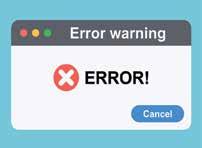
26 VIRGINIA JOURNAL OF EDUCATION | FEBRUARY 2023
INSIGHT ON INSTRUCTION
As a teacher myself, I know this: Teaching isn’t just a job – it’s an extension of your life’s purpose .
— U.S. Secretary of Education Miguel Cardona
to correct you.l
Photo top left and graphic illustration by iStock





VEA’s Store is Open! Represent your union with pride! Access the store here: vea.link/store
FIRST PERSON: NARRATIVES FROM THE CLASSROOM
took Yearbook her junior year, and was one of my three editors her senior year. And, of course, I wasn’t surprised that when wrote glowing college references for her, she told me that she would be studying to become a teacher.
Nowadays, she is Danielle Tolley, partway through her 15th year of teaching for Botetourt County Public Schools, currently a special education teacher at Greenville Elementary School, VEA member, wife, and mother of two. And every year or two, Danielle and I collaborate on some sort of lesson. For example, one of our favorite units is for her elementary school students to create characters and a plot for a Flat Stanley story, while my Creative Writing students give life to those tales with an individualized story for each one of Mrs. Tolley’s pupils.
Recently, Danielle and I were planning another Flat Stanley adventure, and I asked her when she knew she was going to become a teacher.
“Actually, I think it was when was about three years old,” she said. “I would line up all my dolls and hold school for them. Later, when I learned how to write, would make worksheets for my dolls to complete. The dolls would also have to follow instructions for lessons that I wrote on my chalkboard.”
You Could Mentor our Next Generation of Teachers

I vividly remember meeting student Danielle Eubank on the first day of the 2000-01 school year at Lord Botetourt High School in Daleville. That year, I taught both English 9 Honors and Yearbook, and Danielle dropped by my room a half hour before first period began.
“I just wanted to make sure I know where all my classes are, so I’ll be sure to be on time,” she said. “This is honors English 9, isn’t it?”
After assuring her that she had indeed found her third period class, Danielle politely said goodbye and said she was off to her next destination.
I also recall what I said to the teacher who was visiting my room at the time: “I want that girl on my yearbook staff for her sophomore year. bet you that girl’s a future teacher, too.”
As I expected would be the case, Danielle made straight A’s in English 9 Honors, and invited her to be part of yearbook staff her sophomore year, which is when she also earned straight A’s in my English 10 Honors class. That year, I believe, was when I first encouraged her to think about teaching as a career, explaining that her warm, nurturing nature would make her an outstanding elementary school teacher. Danielle also
Decades later, Danielle still enjoys the same aspects of teaching.
“I love the teaching aspect of it all, being with the kids,” she said. “But I also love the planning and creative part of being a teacher. And there’s nothing better than seeing that proverbial light bulb come on when students finally grasp something that they’ve been having trouble with. I’m just happy to be a teacher, despite all the challenges that we have to face these days.”
Over the years, I’ve been fortunate to teach many outstanding young people like Danielle who I encouraged to become teachers. And now, unlike no other time in my nearly 50 years in the classroom, is it more important for current teachers and VEA members to reach out to youngsters who we think have the personal skills, the empathy, ability, and attitude to become the teachers of tomorrow.
Many Virginia school systems, as is true across most of the country, are struggling to fill teaching positions, as you see in the cover story in this issue. College loans, the inherent lower pay of the vocation, and the aftereffects of the COVID pandemic are all factors that can make young people hesitate to enter this profession, as well as cause their parents to try to dissuade them from becoming teachers.
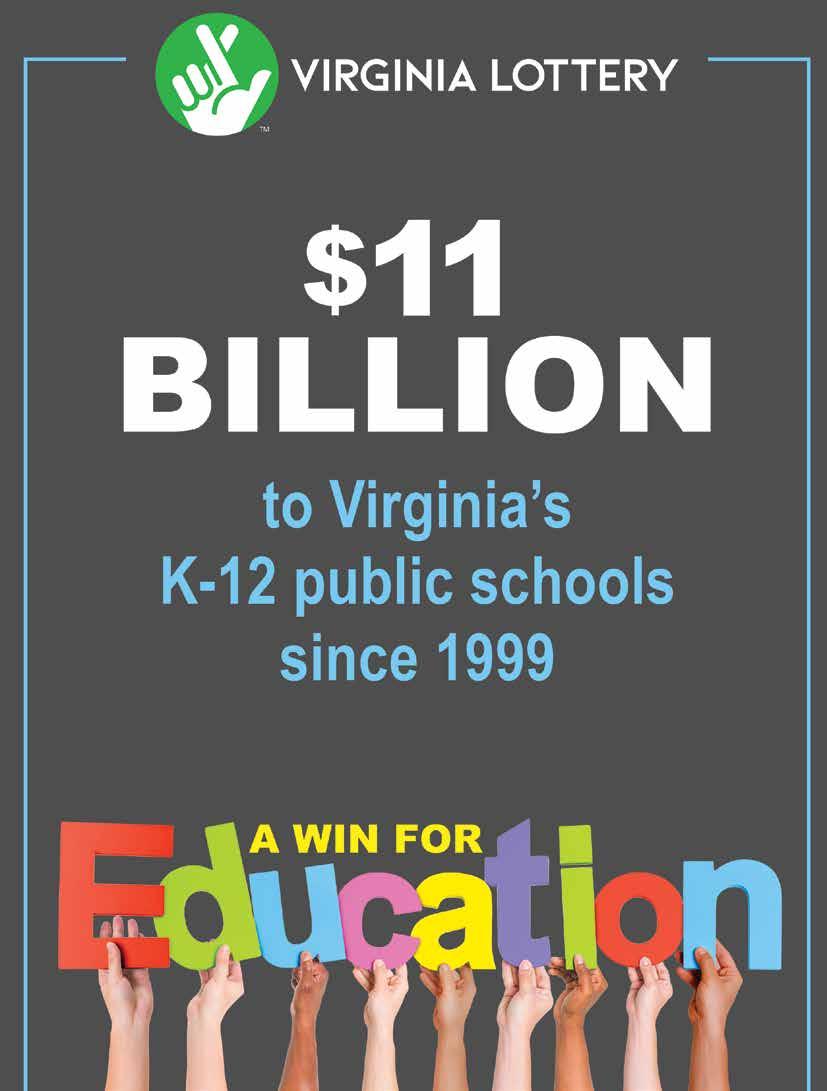
And it’s no secret either that many politicians have sought to demonize teachers for whatever ails society – a negative act that is so dispiriting to those of us who still teach. So consider reaching out to that dynamic young person in your classroom…for the good of society.l

30 VIRGINIA JOURNAL OF EDUCATION | FEBRUARY 2023
Bruce Ingram, a member of the Botetourt Education Association and a veteran educator, teaches English and Creative Writing at Lord Botetourt High School.
— Bruce Ingram Photo by iStock





A publication of the Virginia Education Association 116 South Third Street, Richmond VA 23219 veanea.org vea4Kids








































 — Kristian Ellingsen
— Kristian Ellingsen

 By Simone Kiere and Colleen Brady
By Simone Kiere and Colleen Brady





























